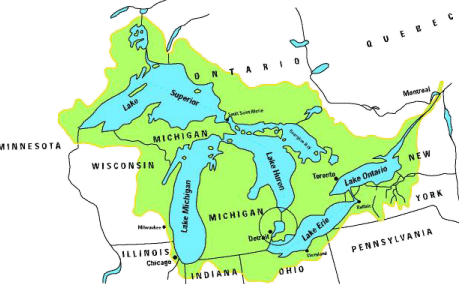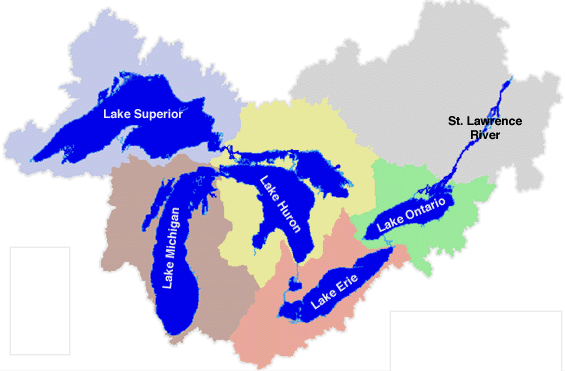The Great Lakes are the largest surface freshwater system on the Earth. The lakes contain about 23,000 cubic kilometres of water, covering a total area of 244,000 square kilometres. This translates to about 84% of North America’s surface fresh water and about 21% of the world’s supply.

Nearly 25% of Canadian agricultural production and 7% of American farm production are located in the Watershed. More than 30 million people live in the Great Lakes Watershed – roughly 10% of the U.S. population and more than 30% of the Canadian population. The daily activities of these people, from the water consumed to the waste returned, directly affect the Great Lakes environments.
Characteristics of the Watershed
Because of the large size of the Great Lakes Watershed, physical characteristics such as climate, soils and topography vary across the Watershed. To the north, the climate is cold and the terrain is dominated by the Canadian Shield, which consists of Precambrian rocks under a generally thin layer of acidic soils. Conifers dominate the northern forests. The northern region of the Great Lakes is sparsely populated and is characterized by coniferous forest and rocky shorelines.
In the southern areas of the Watershed, the climate is much warmer. The soils are deeper with layers or mixtures of clays, silts, sands, gravels and boulders deposited as glacial drift or as glacial lake and river sediments. The lands are usually fertile and can be readily drained for agriculture. Much of the original deciduous forests have given way to agriculture and sprawling urban development.
Characteristics of the Lakes
Although part of a single system, each lake is different.

- Lake Superior
- Lake Michigan
- Lake Huron
- Lake Erie
- Lake Ontario
Lake Superior is the largest in terms of volume. It is also the deepest and coldest of the five lakes. Because of its size, Superior has a retention time of 191 years. Most of the Lake Superior Watershed is forested with little agriculture because of its cool climate and poor soils. The forests and sparse population result in relatively few pollutants entering Lake Superior, except through airborne transport.
Lake Michigan, the second largest, is the only Great Lake entirely within the United States. The northern part is in the colder, less developed upper Great Lakes region. It is sparsely populated, except for the Fox River Valley which drains into Green Bay. The more temperate southern basin of Lake Michigan is among the most urbanized areas in the Great Lakes Watershed. This region is home to about 8 million people or about one-fifth of the total population of the Great Lakes Watershed.
Lake Huron, which includes Georgian Bay, is the third largest of the lakes by volume. Many Canadians and Americans own cottages on the shallow, sandy beaches of Lake Huron and along the rocky shores of Georgian Bay. Check out the Georgian Bay Watershed page to learn more!
Lake Erie is the smallest of the lakes by volume and is exposed to the greatest effects from urbanization and agriculture. Because of the fertile soils surrounding the lake, the area is intensively farmed and receives runoff from the agricultural area of southwestern Ontario and parts of Ohio, Indiana and Michigan. Although the lake has a surface area of approximately 26,000 square kilometres, the average depth is only about 19 metres. It is the shallowest of the five lakes and therefore warms rapidly in the spring and summer, and frequently freezes over in the winter. It also has the shortest retention time of the lakes at 2.6 years. The western basin, comprising about one-fifth of the lake, is very shallow with an average depth of just 7.4 metres.
Lake Ontario, although slightly smaller in surface area, is much deeper than its upstream neighbour, Lake Erie, with an average depth of 86 metres and a retention time of about 6 years. Major urban industrial centers, such as Hamilton and Toronto, are located on its shore. The U.S. shore is less urbanized and is not intensively farmed, except for a narrow band along the lake.
Threats
In spite of their large size, the Great Lakes are sensitive to the effects of a wide range of pollutants. Major stresses on the lakes include toxic and nutrient pollution, invasive species and habitat degradation. Sources of pollution include the runoff of soils and farm chemicals from agricultural lands, waste from cities, discharges from industrial areas and leachate from disposal sites.
The large surface area of the lakes also makes them vulnerable to direct atmospheric pollutants that fall as rain, snow, or dust on the lake surface, or exchange as gases with the lake water. Outflows from the Great Lakes are relatively small (less than 1% per year) in comparison with the total volume of water. Pollutants that enter the lakes are retained in the system and become more concentrated with time.
Addressing these problems is complicated by the fact that the Great Lakes Watershed encompasses large parts of two nations, the United States and Canada.
